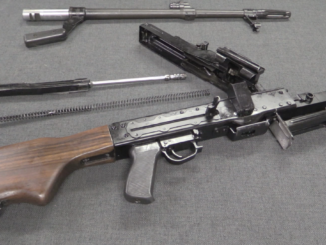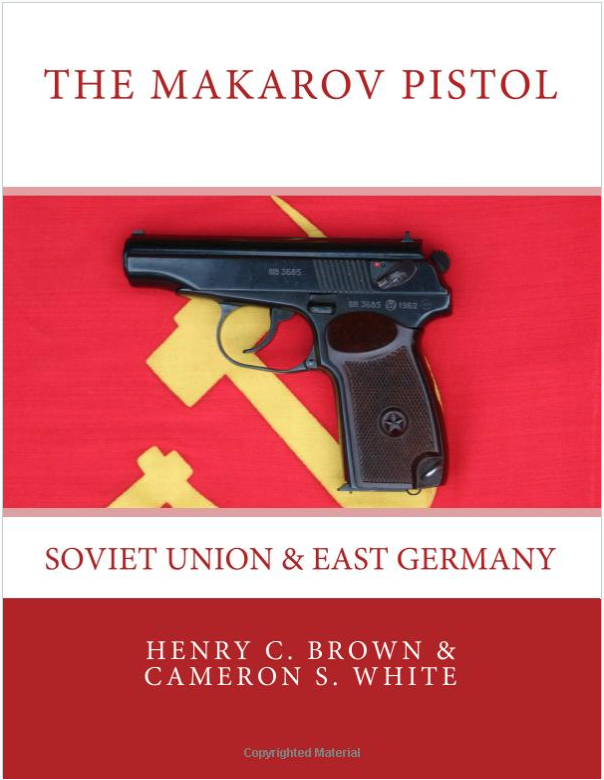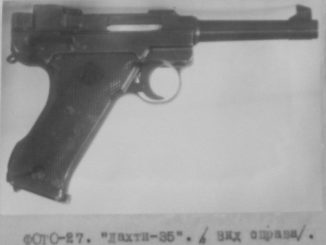The PSM is a Soviet pistol from the late 1970s which has gotten itself quite the fanciful reputation here in the US, thanks to extreme rarity and some imaginative magazine articles. Common lore would have you believe that the PSM and its 5.45x18mm bottlenecked cartridge is capable of astounding feats of armor penetration, and that it was designed specifically for KGB assassins.
The truth is rather more mundane – the PSM was a sidearm for high ranking officers who did not want to deal with carrying a Makarov pistol. Much like the US use of the 1911 and the Colt 1903 back during WW2, general-rank Soviet officers carried sidearms as badges of rank, not as actual combat weapons. To that end, the PSM is extremely thin to make it as unobtrusive as possible. The 5.45x18mm cartridge is basically a centerfire .22 long rifle ballistically. It does offer armor penetration that would be surprising to some, because its metal jacket, mild steel core, and small frontal area are all beneficial in piercing Kevlar. That is a side effect of the design, however, and not an original intent.
Mechanically, the PSM is a simple blowback action, and very similar to the Makarov.
Thanks to Mike Carrick of Arms Heritage magazine for providing the PSM and its ammunition for this video!




Not sure if it would count as an assassination or not, but my understanding is that the reason officers carry pistols (which are pretty much useless in a long-arm combat situation) is to execute reluctant enlisted men, to encourage the others. Speaking as a former reluctant enlisted man…..
PSM was originally designed on request form Internal Affairs ministry as a deep concealment pistol for undercover police officers; it was adopted by military later on.
Also a note – Ian mixes up IZHMECH (IMZ), a factoruy that still produces PSM, and IZHMASH, a factory that produced AK rifles. Today both those factories are united under Kalashnikov concern brand, but back then IMZ/Baikal and IZHMASH were two different bodies.
The reason that infantry officers carried pistols was to defend themselves if need be. An officer’s job was to direct his men, not to fight directly. However, circumstances could arise on the battlefield where they would have to defend themselves. Having officers carry early muskets was a bad idea, as muskets required close attention to operate and the officer was supposed to be keeping aware of his surroundings, not head down fiddling with his musket.
As a result of this, Infantry officers trained to defend themselves from bayonets and cavalry swords or lances using their own swords. Pistols at first supplemented, and later replaced, swords for officers. As both technology and the nature of war changed, pistols replaced swords in that role. As technology changed still further, it became practical in recent times to give them standard infantry rifles for that role.
Senior officers also carried swords, both for reasons of defending themselves in exceptional circumstances, but also because as soldiers on a battlefield they really ought to be armed in some way as a matter of principle. Very senior officer swords were often of a different pattern to those carried by junior officers. This tradition carried through to pistols, resulting in the types mentioned in the video.
A friend of mine used to carry one of them when he lived in South Africa, FWIW 🙂
Not The Chap, by chance?
“PSM is a simple blowback action, and very similar to the Makarov.”
In fact simultaneously with 5,45×18 mm cartridge, automatic pistol was developed which was dwarf version of Makarov, it is known as Пистолет Бабкина БВ-025, see photos here: http://zonwar.ru/pistolet/BV-025.html
It suggest that original goal was weapon to counter aeroplanes hijacking. It lost to PSM, as it was thicker (overall thickness: 20 mm) mainly due to safety lever (see photos in link and cf. to PSM)
Basic data:
cartridge: 5,45×18
Dimension, length (barrel) x height x thickness [mm]: 140 (60) x 100 x 20
Mass without cartridges [g]: 460
Capacity: 8
The PSM is simply another example of the Soviet OCD about having distinct weapons that are equivalent to foreign ones but which do not use a cartridge that can be used by a potential enemy.
Before WW2, high-ranking Soviet personnel generally carried the Tulsa Korovin (TK) pocket pistol, a straight-blowback automatic broadly similar to the Mauser M1910/34 in 6.35mm Browning (.25 ACP). This fulfilled pretty much every requirement of a senior officer’s sidearm (badge of office, can be carried openly in a holster or concealed, useful as a threat, can kill if necessary) without going to complicated lengths.
After the Great Patriotic War, the idea was that no non-Soviet cartridges be used at all. (Remember, 7.63 x 25 Mauser and 7.62 x 25 Tokarev are only one-way interchangeable; 7.63 Mauser in a 7.62 Tokarev chamber is safe, not the other way around.)
Wit that in mind, the 9 x 18 Makarov was developed; equivalent to the Western 9 x 18 Ultra, slightly more powerful than the 9 x 17 SR Browning (.380 ACP), and again only “one-way” interchangeable; .380 or 9 Ultra in 9 Mak, not the other way.
That still left the 6.35mm in the inventory. The logical conclusion in the early Seventies was that since the new service rifle was a 5.45mm bore, make pocket pistols in the same caliber. (Hey, it worked on the Mosin-Nagant and Tokarev.)
Result, a pistol and cartridge that nobody else had and that nobody else could use their own ammunition in. Very much Soviet SOP.
I think it was just that simple.
cheers
eon
“Tulsa Korovin (TK) pocket pistol”
Wait Tulsa is adjective derived from Tula? If not this is wrong name, this name should be given as Tulʹskij Korovina (using ISO-9) or adjective from Tula [I don’t know how adjective-generating work in English, can anyone help] Korovin’s or Tula, Korovin (ignoring any declension)
No, “TulSa” is a finger malfunction on my typing!
😉
cheers
eon
“Wit that in mind, the 9 x 18 Makarov was developed; equivalent to the Western 9 x 18 Ultra, slightly more powerful than the 9 x 17 SR Browning (.380 ACP), and again only “one-way” interchangeable; .380 or 9 Ultra in 9 Mak, not the other way.”
This reminded me about: https://www.youtube.com/watch?v=zGRtEFH7VFg
it should be remembered that 9×18 is not 9 mm like 9×19 Parabellum, but rather 9,2 mm. This mean that, even if you manage to load .380 or Ultra and fire it, accuracy will be seriously hindered (municion org gives following data for bullet diameters: .380 – 8,86 mm; Ultra – 9,01 mm; Makarov – 9,27 mm).
True, but having fired .380 in a 9 x 18 (FEG PA-63 PP clone), at 25 yards it still shoots into about 6 inches, which is “one minute of goon”- close enough to save your backside in a pinch.
The main problem is that while European 9 x 17SR will generally operate the action, with its heavier recoil spring, standard-velocity U.S. .380 may or may not. I experienced some ejection/feed stoppages with U.S. standard generic .380, but European (Czech) 9 x 17 SR worked about as well as the same brand of 9 x 18.
cheers
eon
“Result, a pistol and cartridge that nobody else had and that nobody else could use their own ammunition in. Very much Soviet SOP.”
Later, export version was created for .25 Auto (6,35 mm Browning) cartridge – Baikal-441.
There were at least 2 other pistols using 5.45×18: the Drel (Drill) sporting pistol based on the Margolin and the OTs-23 Drotik (Javelin) select-fire pistol (3 rounds burst at 1700 RPM), also made in semi-auto variant.
“Assassination Gun”
For that role, Soviet Union has more suitable weapons, like for example MSP:
http://modernfirearms.net/handguns/hg/rus/msp-silent-e.html
it is useful due to:
– being silent (muzzle velocity lower than sonic)
– being flash-less (gases are in trap, after firing)
– not ejecting spent cases
– firing 7,62 mm bullet from 7,62 x 39 cartridge – 5,45 x 18 bullet would be clear sign of link to Soviet Union
Not to mention that KGB “wet affairs” officers;
1. Almost never did the job themselves (having learned their lesson from the Stashynsky affair);
2. Were careful to hire their hitters from groups with as little connection to Moscow as possible, and ideally having a previously-existing grudge against the target (Ex; the Gray wolves in the attempt to murder Pope John Paul II);
3. Worked through third parties whenever they could (hence the Bulgarian connection in the attempt on the Pope);
4. And were careful never to supply the actual hitter with any weapon that could be traced back to KGB (Mehmet Ali Ağca gun used a 9mm FN P-35;
https://thenypost.files.wordpress.com/2014/03/popegun.jpg?quality=90&strip=all&w=664&h=441&crop=1
)
Real “spy assassinations” are very different from the way they are portrayed in books and movies. As one retired CIA field officer of my acquaintance once observed, “anyone who did it like they show in the movies wouldn’t make it to the airport before the local cops nabbed him”.
And a KGB officer dolled up like 007 with all sorts of gadgets and special guns would never get in-country to begin with.
cheers
eon
And usually wet work folks would prefer to make assassinations that were more like “conveniently timed accidents.” If you prank the Chinese People’s Liberation Army with ransomware while in China, all one needs to know is that a black Audi showed up in your neighborhood and that you were never seen again! Either that or you met your end curtesy a freight train! Did I mess up?
Nope. Said CIA F.E. went on to say, “Assassinations are ‘executed’ worldwide every day. The local authorities and newsies just don’t realize that they ARE assassinations”.
Never mind a nondescript Volvo showing up on the guy’s block. Look for him to slip, fall, and bust his skull in the bathtub. Or a gas explosion to take out his favorite cap’ joint/Wifi hotspot, with him and a half-dozen of his hactivist buddies there at the time.
“Disappearances” attract attention. “Accidents” don’t.
😉
cheers
eon
““Disappearances” attract attention. “Accidents” don’t.”
There existed so-called “Laboratory X”, leaded by Mairanovsky (from 1937 to 1951):
https://en.wikipedia.org/wiki/Grigory_Mairanovsky
developing and testing various poisons, most notable К-2 (карбиламинхолинхлорид) which was said to cause death in 15 minutes and was undetectable during victim investigation.
However, sometimes the Russians want everyone to know that they have killed someone. Then they use polonium. It acts slowly at first, giving their killers time to flee the country. And then the whole world knows what happens when you make Putin really mad.
“PSM was a sidearm”
Here http://www.nastavleniya.ru/PSM/psms.htm you can read НАСТАВЛЕНИЯ ПО СТРЕЛКОВОМУ ДЕЛУ 5,45-мм Пистолет самозарядный малогабаритный ПСМ, just click on links to get to chapter, after clicking in 1st link (Техническое описание пистолета ПСМ) you can read that
5,45-мм пистолет самозарядный малогабаритный ПСМ (рис. 1) является личным оружием нападения и защиты, предназначенным для поражения противника на коротких расстояниях.
Which mean:
5,45-mm pistol self-loading small-size ПСМ (reference to drawing) is side arm (literally – personal weapon) for attack and defense, destined for hitting enemy at short distances.
“5.45x18mm bottlenecked cartridge”
This cartridge was also used later in few other weapons, one of them is Пистолет “Дрель”, see drawing here:
http://www.megasword.ru/index.php?pg=176
it is derived from Margolin automatic pistol, barrel was shortened and Margolin’s sights was dropped in favor on sights-on-slide style.
Basic data:
Cartridge: 5,45 x 18
Mass, loaded: 0,61 kg
Mass, without cartridges: 0,56 kg
Length (barrel): 190 mm (97 mm)
Capacity: 10
Sights distance: 50 m
Principle of operation: blow-back
“5.45x18mm bottlenecked cartridge”
This cartridge was also used in ОЦ-26 automatic pistol:
http://forum.guns.ru/forum_light_message/18/213907.html
information about it are scarce, it is said to be variant of ОЦ-21 (small automatic pistol for 9×18 Makarov cartridge). ОЦ- designation hints that it was developed in Tula, by ЦКИБ СОО.
Basic data:
Cartridge: 5,45 x 18
Length (barrel): 115 mm or 117 mm (60 mm)
Height: 85 mm
Thickness: 19 mm
Mass: 0,4 kg
Sights distance: 10 m
Capacity: 5
“5.45x18mm bottlenecked cartridge”
OTs-23 Drotik also used this cartridge, this weapon have description in English, so I will skip it here.
And finally probably most exotic weapons from all firing knife «Хамелеон» (“chameleon”):
http://zonwar.ru/news2/news_366_Hameleon.html
which is combination of 4-barreled firearm and knife. Loading is done similar to top-break shotguns (see 1st photo from top). This weapon might be fired even if scabbarded (hope that this is proper equivalent of revolver’s holstered) in which case scabbard acts like silencer (muzzle velocity is not given, barrel length is not given, so I can’t say whatever it is subsonic or supersonic – PSM has muzzle velocity 310 m/s according to manual I linked earlier, which is less than but close to sound @ ~340 m/s).
Even more exotic variant exist – for 4,5х40 мм R cartridge, which mean that this variant is underwater firing knife.
I was present at the Police Scientific Development Branch in the UK when the PSM was investigated by Maurice Hicks. The surprising body armour penetration was assumed to be unintentional, just an effect of the unusually high l/d ratio for the projectile as Ian stated 14.3mm for the jacketed design. It was assumed that the projectile was longer to allow for more support in the case neck to make the cartridge more robust for handling. The .22 LR can have the heeled area loosened by mishandling.
One interesting fact that was noted was the amount the primer bulged out of the primer pocket after firing.
–>eon, Daweo, 9mmx20(nine browning long) is semi rimmed, while 380ACP/9kurz is(with a 45ACP) as close as possible to definition of rimless case.
Not only base diameter is equal to rim diameter, but there is practically no taper at all(funny thing is that “true” rimless cartidges had substantial body taper).
On the video Ian says that 5.45×18mm is ballistically equivalent to standard velocity .22 lr. That is true only in the sense that the latter has about the same muzzle velocity out of a rifle barrel as the former from the 3.3″ barrel of the PSM. In order the get the same muzzle energy velocity with a .22 lr from a 3.5″ barrel you need to get the hottest high velocity factory loadings available, such as the CCI Velocitor. .22 lr is of course usually loaded with rifle powder, so potentially you could get even slightly higher velocities from pistol barrels with faster pistol powders, but I am not aware of any such loadings.
22lr is loaded with a fast burning powder(just like shotgun or pistol ammo).
Check its pressure curve.
Where should I try to obtain such curves? Manufacturers do not provide them and neither do they usually tell what powder they are using. Not that I dispute what you are saying, but I have just always assumed .22 lr is normally loaded with slower burning rifle powder. It is, after all, originally a rifle cartridge and its use in pistols is still limited mostly to target shooting¹. The target loads are mild and formulated for maximum accuracy (consistency), so I didn’t really consider them.
¹ Yes, I am aware that there are revolvers and even semiauto pistols in .22 lr intended for self-defense use, but in the big picture they are not hugely popular.
Even online – but look for pressure vs barrel lenght(or travel distance), not travel time.
Peak pressure for the 22lr is around chamber, and for typical rifle/carbine rounds, long after forcing cone.
IIRC, .22lr typically burns all powder by 11″ barrel length.
Check
https://www.theboxotruth.com/
I think that was the site that cut a rifle barrel in one inch segments to test velocity.
“I think that was the site that cut a rifle barrel in one inch segments to test velocity.”
Don’t you confused it with: http://www.ballisticsbytheinch.com/22.html
?
Giving rather 1.3 times bigger momentum for a pocket pistol caliber through bottle necked case, providing steel core bullet might not be explained by “side effects”. There it seems that, this pistol, from forged, well machined all its pieces to very well designed, effective, no sidewarly protruding safety latch, is developed to get a discreet Carry, effective service handgun, nearly same as the approach of current FN Five Seven.
I’d like to point out that the FN Five Seven is not a discrete carry gun, but a full size service pistol, originally designed to replace the various 9mm Parabellum service pistols in NATO service.
True. What I was pointing out is, the similarity in selecting the way of caliber and type of round which targeted.
Correction; 1,3 times should be;1,7
cartierlovejesduas Because they want to kill art and replace it with automation?
replik cartier anhänger love http://www.billigschmuckverkauf.com/
La concepción del cartucho por parte de Denisova es interesante, aunque 60% lograda. Este cartucho asi como fue concebido admite sin ningún problema una velocidad de 1250 pies por segundo sin ninguna sobrepresión, cómodo para una pistola copia de Walther de acero. 2do) El largo proyectil del 5.45 tiene la ventja de desestabilizarse según el blanco y el hecho de que fuera supersónico lo ayuda mucho en la efectividad que éste en realidad no tiene. La poca profesionalidad del diseño también se ve en el hecho de que la psm no tuviera una delicada doble acción que permitiera “abanicar” primero.-